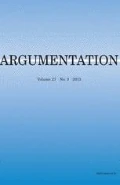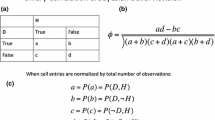Abstract
Whereas there are many publications in which argumentation quality has been defined by argumentation theorists, considerably less research attention has been paid to lay people’s considerations regarding argument quality. Considerations about strong and weak argumentation are relevant because they can be compared with actual persuasive success. Argumentation theorists’ conceptions have to some extent been shown to be compatible with actual effectiveness, but for lay people such compatibility has yet to be determined. This study experimentally investigated lay people’s expectations about the persuasiveness of anecdotal, statistical, causal, and expert evidence, and compared these expectations with the actual persuasiveness of these evidence types. Dutch and French participants (N = 174) ranked four types of evidence in terms of their expected persuasiveness for eight different claims. Both cultural groups expected statistical evidence to be the most persuasive type of evidence to other people, followed by expert, causal, and, finally, anecdotal evidence. A comparison of these rankings with the results of Hornikx and Hoeken (Communication Monographs 74, 443–463, 2007, Study 1) on the actual persuasiveness of the same evidence types reveals that people’s expectations are generally accurate: How relatively persuasive they expect evidence types to be often corresponded with their actual persuasiveness.
Similar content being viewed by others
Notes
An example of a study that investigated lay people’s accuracy at evaluating normatively strong argumentation is Jacobs et al. (1985). In two studies, it was demonstrated that lay people prefer valid conclusions from syllogisms to invalid conclusions when these valid conclusions were argued for by another person.
As Hornikx and Hoeken (2007) explain, there is a relation between evidence types and argument types. Whereas evidence focuses on the type of data that support claims, argument types focus on the relationship between the argument (evidence) and the claim. There is no one-to-one relationship between evidence types and argument types, because anecdotal evidence and statistical evidence are both related to arguments by generalization.
Participants’ gender did not affect the mean rankings of statistical, causal, or expert evidence (ps > 0.10), but it did have an effect on anecdotal evidence (z = 3.78, p < 0.001). Men (M = 3.32, SD = 0.75) ranked anecdotal evidence as more persuasive than women (M = 3.67, SD = 0.53). Next, age only significantly correlated with statistical evidence: r(174) = −0.21, p < 0.01 (other evidence types: ps > 0.05).
The rankings were pooled across the four versions, because there were no effects of version on the mean ranking of anecdotal evidence (Kruskal–Wallis χ2(3) = 6.12, p = 0.11), statistical evidence (χ2(3) = 3.81, p = 0.28), causal evidence (χ2(3) = 1.05, p = 0.79), or expert evidence (χ2(3) = 5.15, p = 0.16).
As a check with Hornikx and Hoeken (2007, Study 1), this questionnaire also included measures that were relevant to the cross-cultural investigation of expert evidence in that study. After the eight rankings of the evidence types, the Preference for Expert Information scale (PEI; Hornikx and Hoeken 2007), and seven items of the Need for Cognition scale (NFC; Cacioppo et al. 1984) were included. The first four items of the PEI scale proved to be reliable, both for the French participants (α = .73), and for the Dutch participants (α = .75). Dutch (M = 2.51, SD = 0.69) and French participants (M = 11 2.52, SD = 0.77) scored equally on the PEI scale (t(172) = 0.95, p = .35). The NFC scale was reliable for the French participants (α = .74), but not for the Dutch (α = .58). For each expert in the expert evidence, participants indicated their perceived expertise. The experts were considered as persons with relatively high expertise, as the mean perceived expertise scored above the midpoint (3.00) of the scale for the French (M = 3.25, SD = 0.60; t(85) = 3.82, p < .001) and the Dutch participants (M = 3.52, SD = 0.54; t(87) = 9.17, p < .001).
The range of rank scores for the eight claims for the Dutch was: 1.19–1.31 for statistical, 2.24–2.39 for expert, 2.56–2.87 for causal, and 3.67–3.78 for anecdotal evidence. For the French, the range of rank scores was: 1.36–1.71 for statistical, 2.22–2.47 for expert, 2.55–2.92 for causal, and 3.27–3.51 for anecdotal evidence.
In both studies, the participants were mostly students at Humanities faculties. The Dutch students in this study (M = 19.48) were younger than in Hornikx and Hoeken (2007, Study 1) (M = 20.98), and the French students in this study (M = 22.05) were older than in Hornikx and Hoeken (2007, Study 1) (M = 20.75). In this study, the percentage of male students was 45.3% (French) or 14.8% (Dutch), whereas the percentages were lower in Hornikx and Hoeken (2007, Study 1) (Dutch: 22.6%; French: 13.2%). In both studies, however, age and gender hardly affected the actual or expected persuasiveness of evidence types.
References
Allen, M., and R.W. Preiss. 1997. Comparing the persuasiveness of narrative and statistical evidence using meta-analysis. Communication Research Reports 14: 125–131.
Allen, M., R.W. Preiss, and B.M. Gayle. 2006. Meta-analytic examination of the base-rate fallacy. Communication Research Reports 23, 45–51.
Areni, C.S., and R.J. Lutz. 1988. The role of argument quality in the elaboration likelihood model. In Advances in consumer research, ed. M.J. Houston, vol. 15, 197–203. Provo: Association for Consumer Research.
Baesler, E.J., and J.K. Burgoon. 1994. The temporal effects of story and statistical evidence on belief change. Communication Research 21: 582–602.
Cacioppo, J.T., R.E. Petty, and C.F. Kao. 1984. The efficient assessment of need for cognition. Journal of Personality Assessment 48, 306–307.
Dillard, J.P., K.M. Weber, and R.G. Vail. 2007. The relationship between the perceived and actual effectiveness of persuasive messages: A meta-analysis with implications for formative campaign research. Journal of Communication 57, 613–631.
Feteris, E.T. 2002. Pragmatic argumentation in a legal context. In Advances in pragma-dialectics, ed. F.H. van Eemeren, 243–260. Amsterdam/Newport News: Sic Sat/Vale Press.
Garssen, B.J. 1997. Argumentatieschema’s in pragma-dialectisch perspectief: Een theoretisch en empirisch onderzoek [Argumentation schemes in a pragma-dialectical perspective: A theoretical and empirical study]. Amsterdam: IFOTT.
Hesslow, G. 1988. The problem of causal selection. In Contemporary science and natural explanation: Commensense conceptions of causality, ed. D.J. Hilton, 11–32. Brighton: Harvester Press.
Hoeken, H. 2001. Anecdotal, statistical, and causal evidence: Their perceived and actual persuasiveness. Argumentation 15: 425–437.
Hoeken, H., and L. Hustinx. 2003. The relative persuasiveness of different types of evidence. In Proceedings of the 5th conference of the International Society for the Study of Argumentation, eds. F.H. van Eemeren, J.A. Blair, C.A. Willard, and A.F. Snoeck Henkemans, 497–501. Amsterdam: Sic Sat.
Hornikx, J. 2005. A review of experimental research on the relative persuasiveness of anecdotal, statistical, causal, and expert evidence. Studies in Communication Sciences 5: 205–216.
Hornikx, J. 2007. Is anecdotal evidence more persuasive than statistical evidence? A comment on classic cognitive psychological studies. Studies in Communication Sciences 7: 151–164.
Hornikx, J., and H. Hoeken. 2007. Cultural differences in the persuasiveness of evidence types and evidence quality. Communication Monographs 74: 443–463.
Hornikx, J., M. Starren, and H. Hoeken. 2003. Cultural influence on the relative occurrence of evidence types. In Proceedings of the 5th conference of the International Society for the Study of Argumentation, eds. F.H. van Eemeren, J.A. Blair, C.A. Willard, and A.F. Snoeck Henkemans, 531–536. Amsterdam: Sic Sat.
Jacobs, S., M. Allen, S. Jackson, and D. Petrel. 1985. Can ordinary actors recognize a valid conclusion if it walks up and bites them on the butt? In Argument and social practice: Proceedings of the 4th SCA/AFA conference on argumentation, eds. J.R. Cox, M.O. Sillars, and G.B. Walker, 665–674. Annandale: Speech Communication Association.
Kline, J.A. 1971a. A Q-analysis of encoding behavior in the selection of evidence. Speech Monographs 37: 190–197.
Kline, J.A. 1971b. Dogmatism of the speaker and selection of evidence. Speech Monographs 38: 354–355.
Levasseur, D., and K.W. Dean. 1996. The use of evidence in presidential debates: A study of evidence levels and types from 1960 to 1988. Argumentation and Advocacy 32: 129–142.
Murphy, P.K. 2001. What makes a text persuasive? Comparing students’ and experts’ conceptions of persuasiveness. International Journal of Educational Research 35: 675–698.
O’Keefe, D.J. 1993. Understanding social influence: Relations between lay and technical perspectives. Communication Studies 44: 228–238.
O’Keefe, D.J. 1995. Argumentation studies and dual-process models of persuasion. In Perspectives and Approaches: Proceedings of the 3rd ISSA Conference on Argumentation, eds. F.H. van Eemeren, R. Grootendorst, J.A. Blair, and C.A. Willard, 3–17. Amsterdam: Sic Sat.
O’Keefe, D.J. 2002a. Persuasion: Theory and research. 2nd ed. Thousand Oaks: Sage.
O’Keefe, D.J. 2002b. The persuasive effects of variation in standpoint articulation. In Advances in Pragma-dialectics, ed. F.H. van Eemeren, 65–82. Amsterdam/Newport News: Sic Sat/Vale Press.
O’Keefe, D.J. 2005. News for argumentation from persuasion effects research: Two cheers for reasoned discourse. In Critical problems in argumentation: Selected papers from the 13th biennial conference on argumentation, ed. C.A. Willard, 215–221. Washington: National Communication Association.
O’Keefe, D.J. 2007. Potential conflicts between normatively-responsible advocacy and successful social influence: Evidence from persuasion effects research. Argumentation 21: 151–163.
Parrott, R., K. Silk, K. Dorgan, C. Condit, and T. Harris. 2005. Risk Comprehension and judgments of statistical evidentiary appeals: When a picture is not worth a thousand words. Human Communication Research 31: 423–452.
Petty, R.E., and J.T. Cacioppo. 1986. Communication and persuasion: Central and peripheral routes to attitude change. New York: Springer.
Reinard, J.C. 1988. The empirical study of the persuasive effects of evidence: The status after fifty years of research. Human Communication Research 15: 3–59.
Reynolds, R.A., and J.L. Reynolds. 2002. Evidence. In The persuasion handbook: Developments in theory and practice, eds. J.P. Dillard, and M. Pfau, 427–444. Thousand Oaks: Sage.
Rokeach, M. 1960. The open and closed mind. New York: Basic Books.
Schellens, P.J. 1985. Redelijke argumenten: Een onderzoek naar normen voor kritische lezers [Reasonable arguments: A study in criteria for critical readers]. Dordrecht: Foris.
Van Eemeren, F.H., R. Grootendorst, S. Jackson, and S. Jacobs. 1993. Reconstructing argumentative discourse. Tuscaloosa: University of Alabama Press.
Van Eemeren, F.H., R. Grootendorst, and F. Snoeck Henkemans. 1996. Fundamentals of argumentation theory: A handbook of historical backgrounds and contemporary developments. Mahwah: Lawrence Erlbaum.
Van Enschot-Van Dijk, R., L. Hustinx, and H. Hoeken. 2003. The concept of argument quality in the elaboration likelihood model: A normative and empirical approach to Petty and Cacioppo’s ‘strong’ and ‘weak’ arguments. In Anyone who has a view: Theoretical contributions to the study of argumentation, eds. F.H. van Eemeren, J.A. Blair, C.A. Willard, and A.F. Snoeck Henkemans, 319–335. Dordrecht: Kluwer.
White, H.A. 1997. Considering interacting factors in the third-person effect: Argument strength and social distance. Journalism and Mass Communication Quarterly 74: 557–564.
Wilson, S.R. 2002. Seeking and resisting compliance: Why people say what they do when trying to influence others. Thousand Oaks: Sage.
Acknowledgements
Thanks to Chantal Claudel and Sonia Gouirand for their practical help with the experiment, and to Hans Hoeken and Daniel O’Keefe for discussions of issues addressed in this article.
Author information
Authors and Affiliations
Corresponding author
Rights and permissions
About this article
Cite this article
Hornikx, J. Comparing the Actual and Expected Persuasiveness of Evidence Types: How Good are Lay People at Selecting Persuasive Evidence?. Argumentation 22, 555–569 (2008). https://doi.org/10.1007/s10503-007-9067-6
Received:
Accepted:
Published:
Issue Date:
DOI: https://doi.org/10.1007/s10503-007-9067-6




